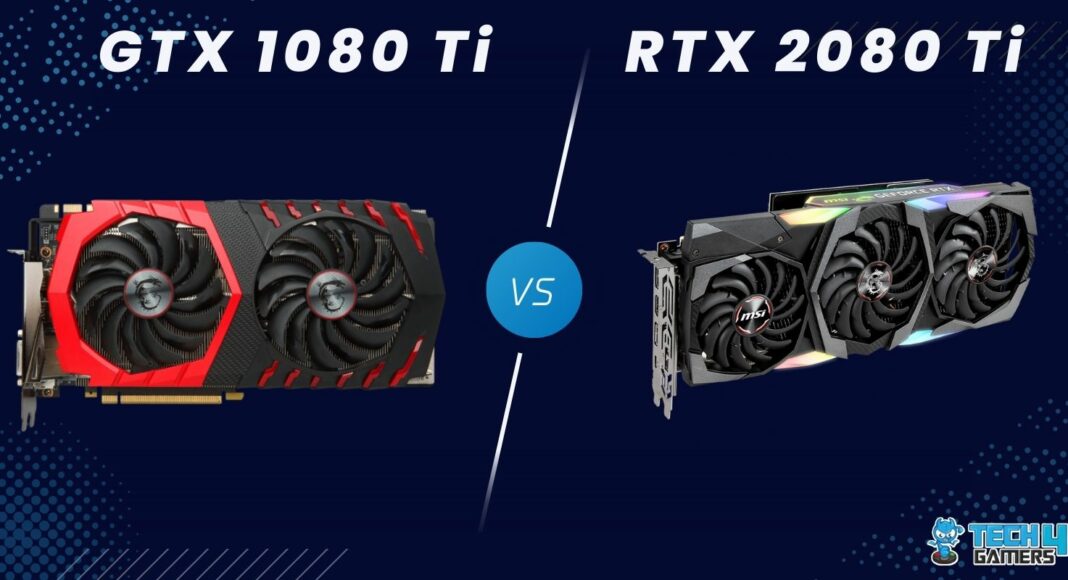GTX 1080 Ti
Rated: 8.3/10
RTX 2080 Ti
Rated: 8.8/10
Pros And Cons
| GPU | Pros | Cons |
|---|---|---|
| GTX 1080 Ti | ✅ Cost-Effective ✅ Reliable Performance | ❌ Lacks Ray Tracing Support ❌ Limited AI Performance |
| RTX 2080 Ti | ✅ Ray Tracing Support ✅ AI Processing | ❌ Higher Price Tag ❌ Performance Struggles at 4K Ultra |
- The RTX 2080 Ti outperforms the GTX 1080 Ti by a significant margin, representing a performance increase of approximately 34%.
- Despite the GTX 1080 Ti consuming slightly less power than the RTX 2080 Ti, the latter achieves a 30% better performance per watt, resulting in superior efficiency.
- A performance per dollar metric of 0.18 frames/dollar for the RTX 2080 Ti and 0.26 frames/dollar for the GTX 1080 Ti shows a difference of about 42%.
- Despite its higher price tag, the RTX 2080 Ti is recommended for users seeking top-tier performance and features like DLSS and ray-tracing support. Conversely, the GTX 1080 Ti remains an attractive option for budget-conscious gamers.
Comparison Table
| Technical Specs | GeForce RTX 2080 Ti | GeForce GTX 1080 Ti |
|---|---|---|
| GPU Name | TU102 | GP102 |
| CUDA Cores | 4352 | 3584 |
| Tensor Cores | 544 | 0 |
| RT Cores | 68 | 0 |
| ROPs | 88 | 88 |
| TDP | 250 W | 250 W |
| Suggested PSU | 600 W | 600 W |
Architecture Differences
- Architecture: The RTX 2080 Ti is based on Turing architecture, while the GTX 1080 Ti is based on Pascal architecture. Turing introduces advancements like DLSS and Ray Tracing, setting a new standard for GPU capabilities.
- Clock Speeds: The base clock of the RTX 2080 Ti is 1350MHz, with a boost clock of 1545MHz. The GTX 1080 Ti has a higher base clock of 1481MHz and a higher boost clock of 1582MHz.
- Process Size: The RTX 2080 Ti utilizes a 12nm process size, while the GTX 1080 Ti utilizes a 16nm process size.
- VRAM: The RTX 2080 Ti has 11GB of GDDR6 memory, while the GTX 1080 Ti has 11GB of GDDR5X memory.
The release of the RTX series of graphics cards brought with them some exciting features like DLSS and ray-tracing, but does the raw improvement in performance in the higher-end cards warrant an upgrade? In the GTX 1080 Ti vs RTX 2080 Ti comparison, I will test both GPUs in real-world gaming scenarios to help you decide on your upgrade.
Gaming Performance Benchmarks
These tests were done in a controlled environment utilizing a test bench, the specifications of which are listed below:
Testing Rig
- OS – Windows 11
- CPU – Intel Core i5-13600K
- Motherboard – MSI MEG Z790 ACE MAX Motherboard
- RAM – G.SKILL Trident Z5 RGB 32GB DDR5 6000MHz
- CPU Cooler – MSI MAG CORELIQUID C360
- SSD – XPG GAMMIX S70 BLADE 2TB NVMe SSD
- Power Supply – ENERMAX REVOLUTION D.F. X 1050W
Atomic Heart (Max Settings)
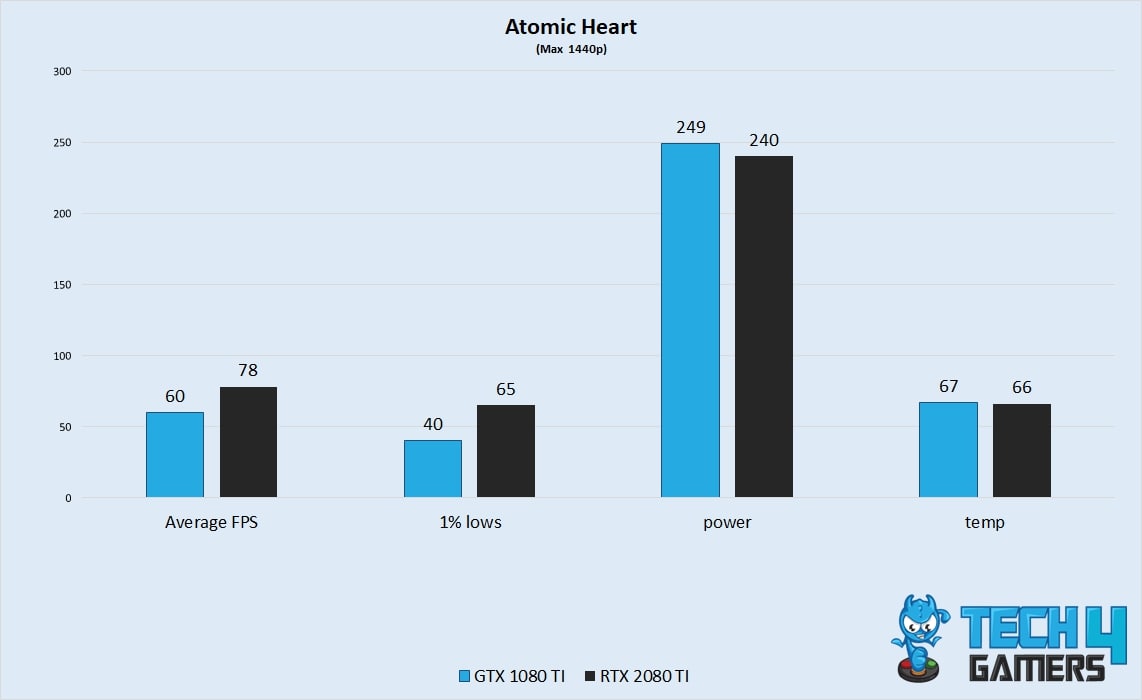
- In the first game of our testing, the RTX 2080 Ti managed to get 78 FPS on average, whereas the GTX 1080 Ti managed to get 60 FPS.
- The RTX 2080 Ti had smooth 1% lows of 65 FPS, whereas the RTX 1080 Ti gave a slightly stuttery performance with 1% lows of 40 FPS.
Red Dead Redemption 2 (Ultra Settings)
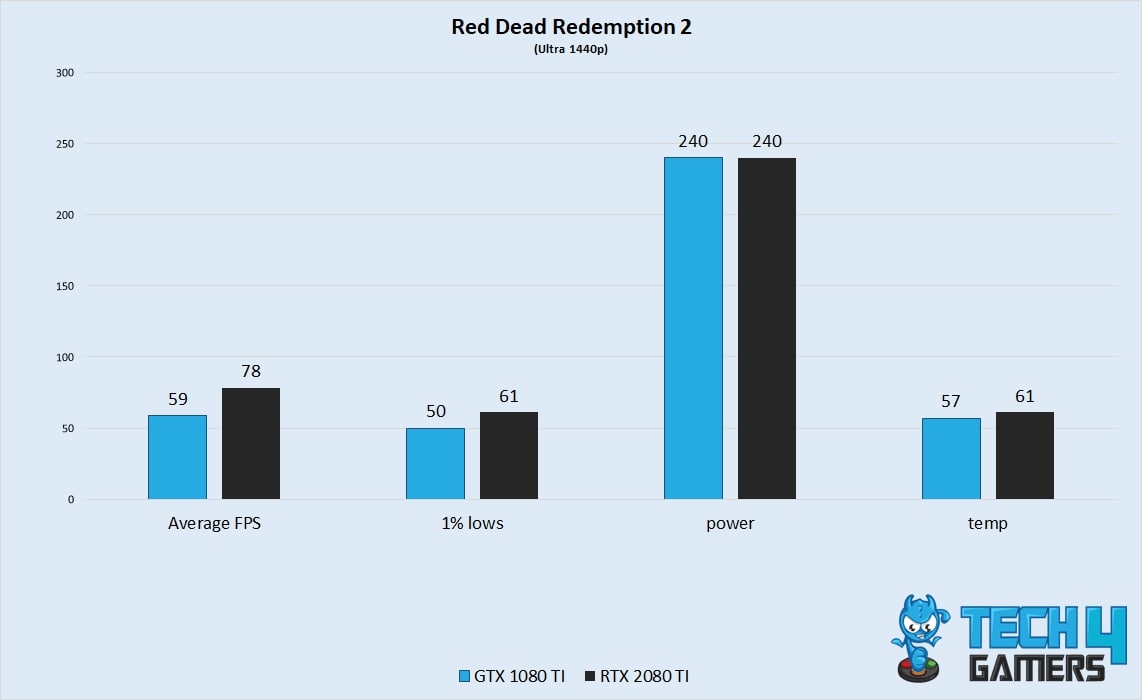
- Both cards gave respectable numbers in Red Dead Redemption 2. The GTX 1080 Ti managed an average of 59 FPS, whereas the RTX 2080 Ti had an average of around 78 FPS.
- The 1% lows in this title were not bad either, with the GTX 1080 Ti having 1% lows of 50 FPS and the RTX 2080 Ti having lows of about 61 FPS.
The Last Of Us Part 1 (Ultra Settings)
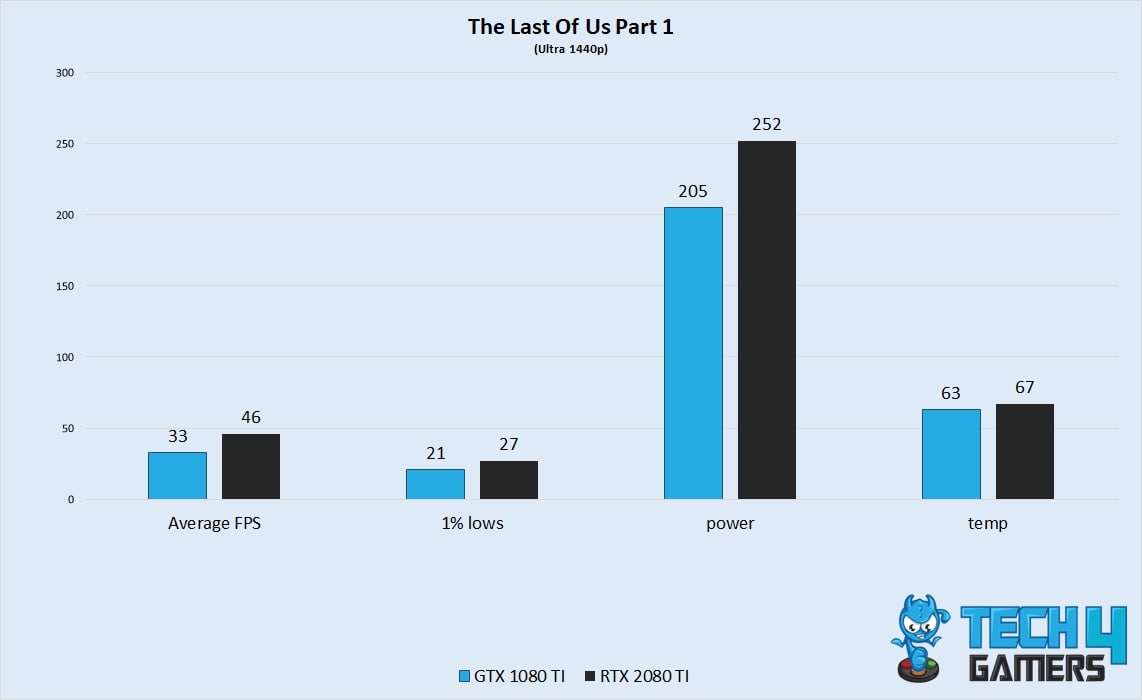
- The Last of Us Part 1 did not run great on either of the cards. The GTX 1080 Ti achieved an average of 33 FPS, while the RTX 2080 Ti demonstrated a higher average of 46 FPS, providing smoother gameplay.
- The 1% lows in this badly-optimized game were not incredible either. The RTX 2080 Ti had a 1% lows of 27 FPS, whereas the GTX 1080 Ti had a worse 1% low of 21 FPS.
Cyberpunk 2077 (High Settings)
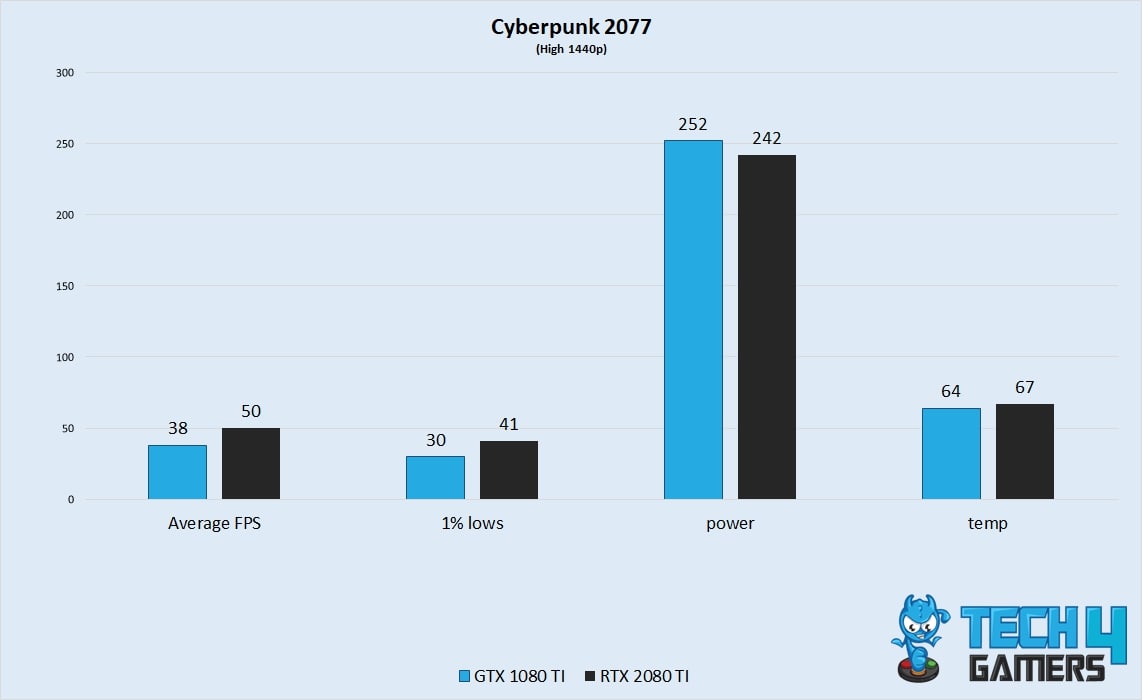
- The RTX 2080 Ti managed a frame rate of about 50 FPS, whereas the GTX 1080 Ti barely got 38 FPS on average.
- The 1% lows were much closer to the average FPS in this title than the last one, which is always a good sign for smoothness. The RTX 2080 Ti had 1% lows at 41 FPS, while the GTX 1080 Ti had 30 FPS in this metric.
Microsoft Flight Simulator 2020 (Ultra Settings)
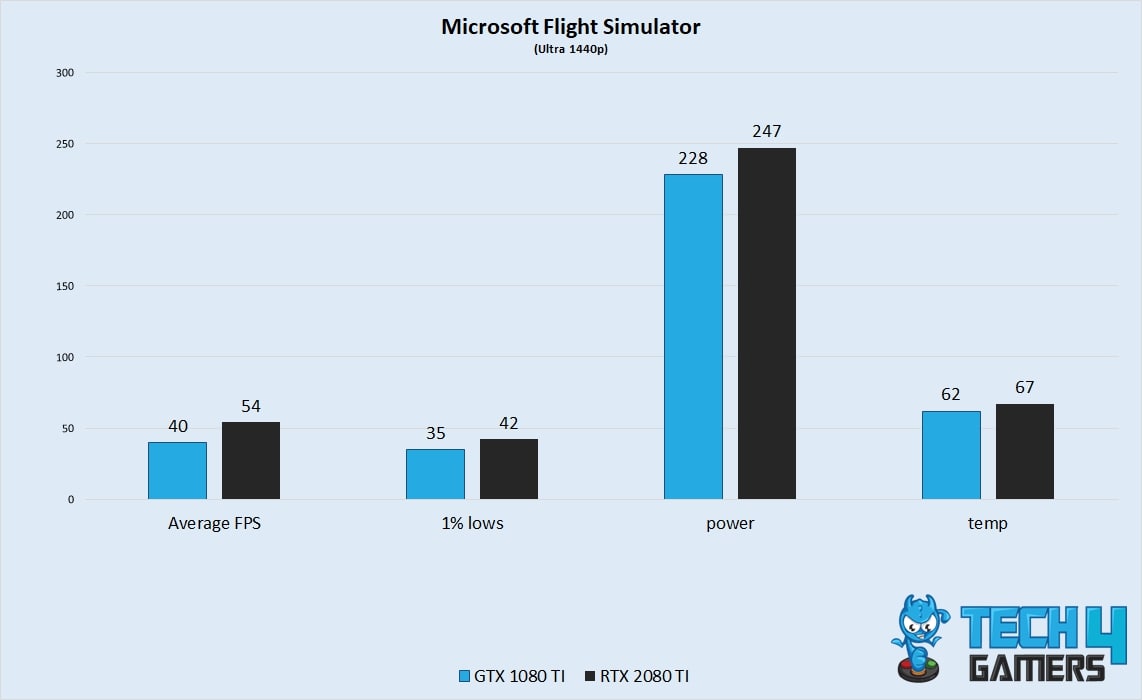
- Keeping the demanding game trend, Microsoft Flight Simulator performed better on these cards than the last two titles. On average, the GTX 1080 Ti got 40 FPS, whereas the RTX 2080 Ti got 54 FPS.
- The GTX 1080 Ti got a 1% lows of 35 FPS, whereas the RTX 2080 Ti got a 1% lows of 42 FPS. This closeness of the averages and 1% lows indicate good optimization.
Hitman 3 (Ultra Settings)
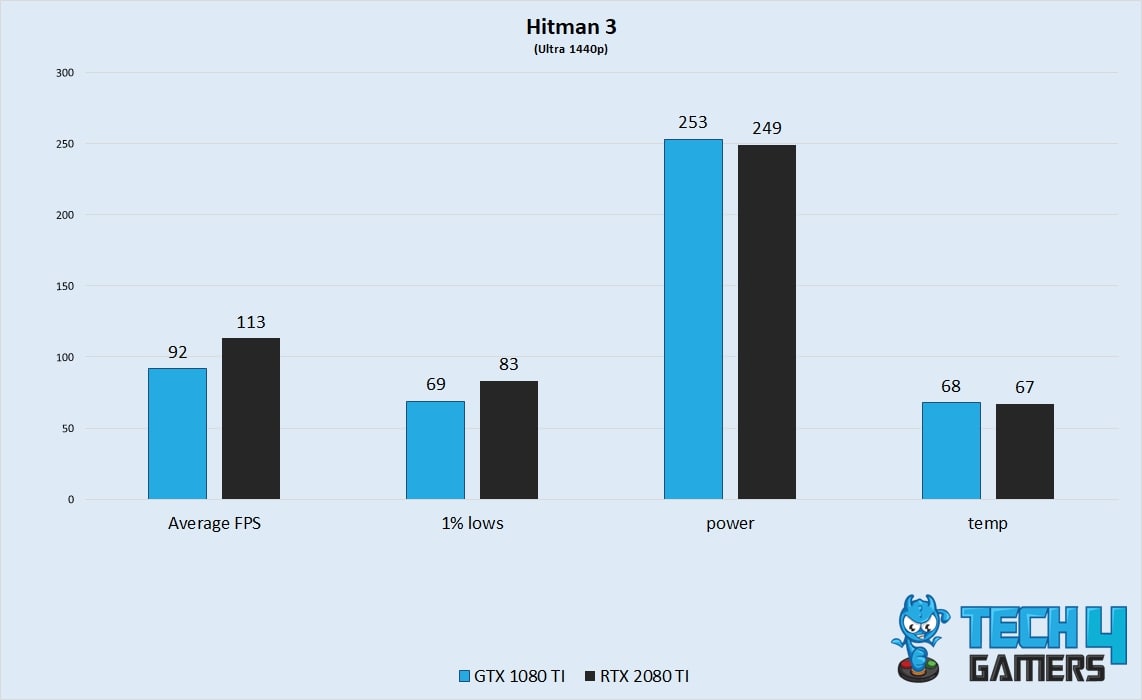
- The GTX 1080 Ti averaged 92 FPS, whereas the RTX 2080 Ti had an average framerate of around 113 FPS.
- 1% lows were also respectable for both graphics cards in this game. The GTX 1080 Ti had a 1% lows of 69 FPS, whereas the RTX 2080 Ti had a 1% lows of 83 FPS.
Forza Horizon 5 (Ultra Settings)
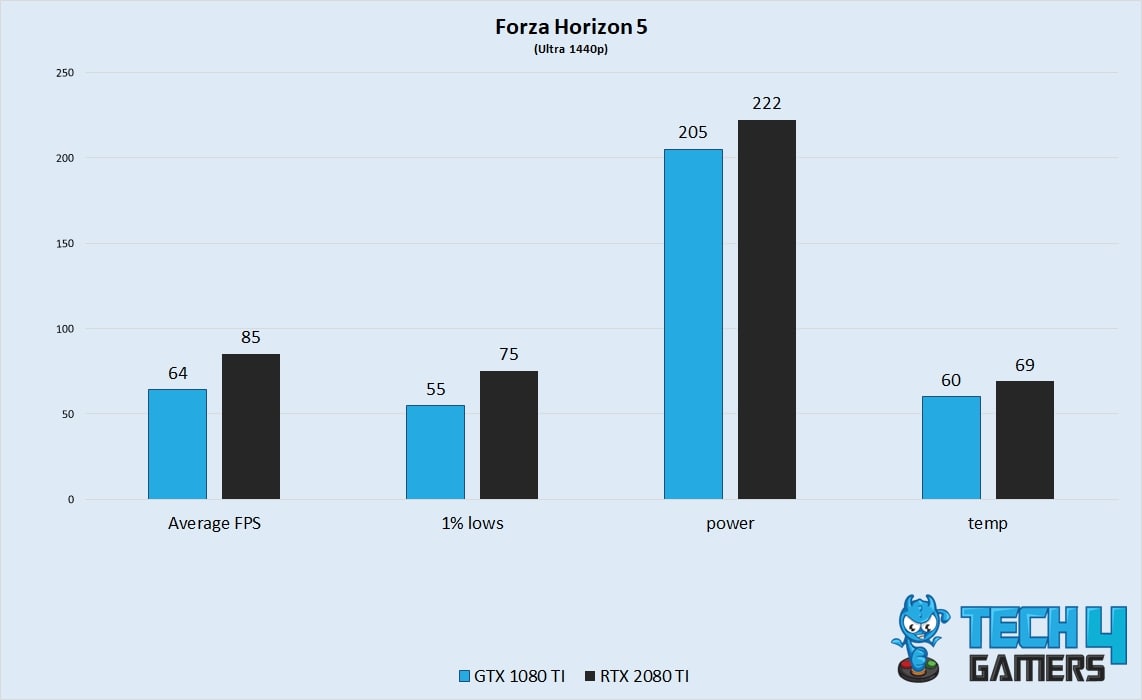
- The RTX 2080 Ti showcased an average of approximately 85 FPS, surpassing the GTX 1080 Ti’s average of 64 FPS.
- Regarding 1% lows, the RTX 2080 Ti also outperformed the GTX 1080 Ti, with 75 FPS and 55 FPS, respectively.
Hogwarts Legacy (Ultra Settings)
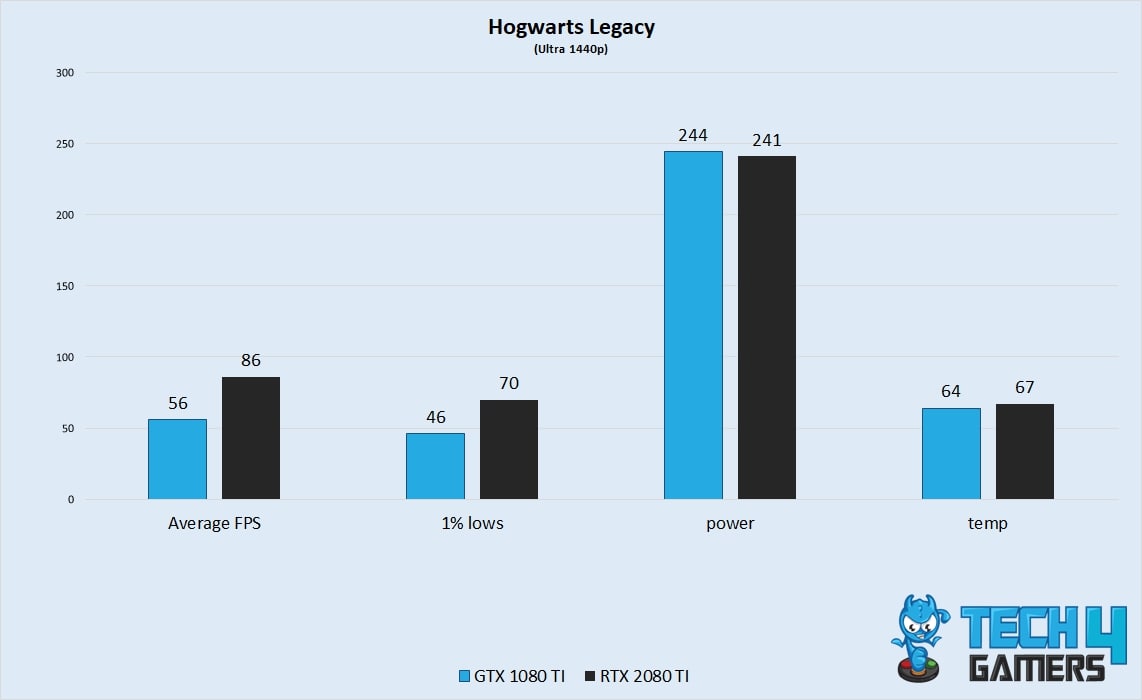
- For the last game in the tests, the RTX 200 Ti had a higher frame rate of about 86 FPS, whereas the GTX 1080 Ti had an average of 56 FPS.
- Regarding 1% lows, the RTX 2080 Ti also outperformed the GTX 1080 Ti, with 70 FPS compared to 46 FPS, respectively.
Overall Gaming Performance
Frame Rate
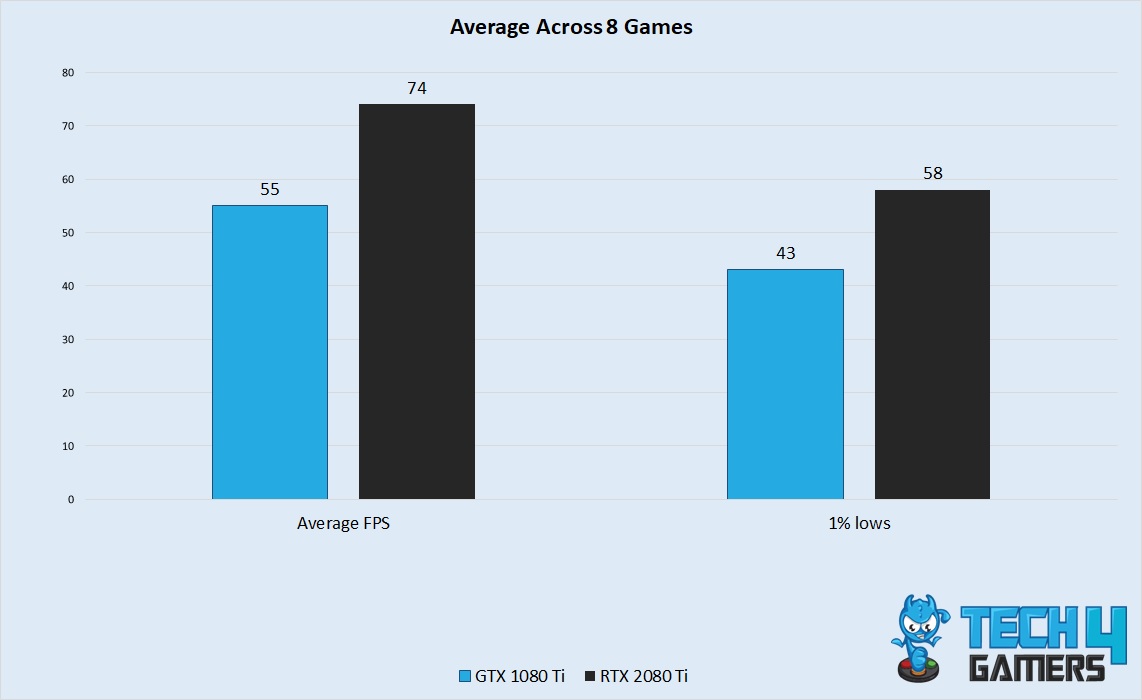
The GTX 1080 Ti had a 55 FPS average over 8 games in our testing. In contrast, the RTX 2080 Ti had an average of 74 FPS in the same 8 games. Switching gears to 1% lows, both the cards had sub-sixty scores on average. The 1080 Ti had a 1% lows of 43 FPS, whereas the RTX 2080 Ti was almost there with 58 FPS.
Winner: RTX 2080 Ti
Power
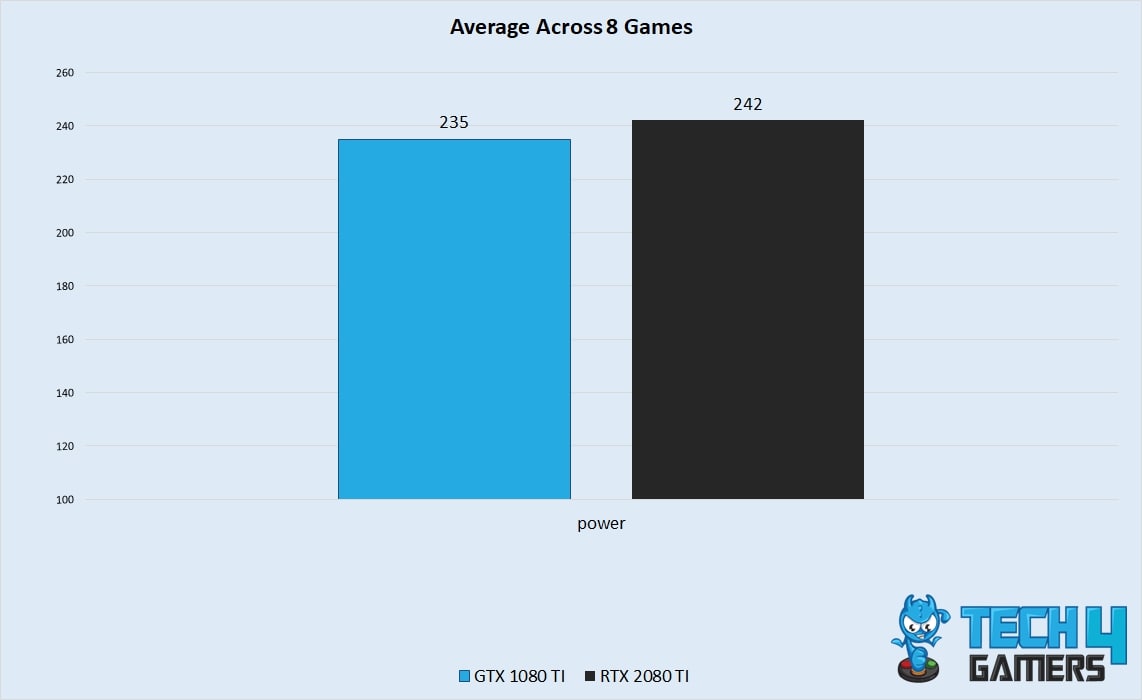
Surprisingly, both these GPUs had similar numbers in terms of power consumption. The RTX 2080 Ti had an average power consumption of 242 watts, whereas the GTX 1080 Ti had a slightly lower power consumption of 235 watts.
This and the higher FPS counts allow the RTX 2080 Ti to reach a much higher performance per watt than the GTX 1080 Ti. The difference here was about 30% favoring the RTX 2080 Ti.
Winner: GTX 1080 Ti
Temperatures
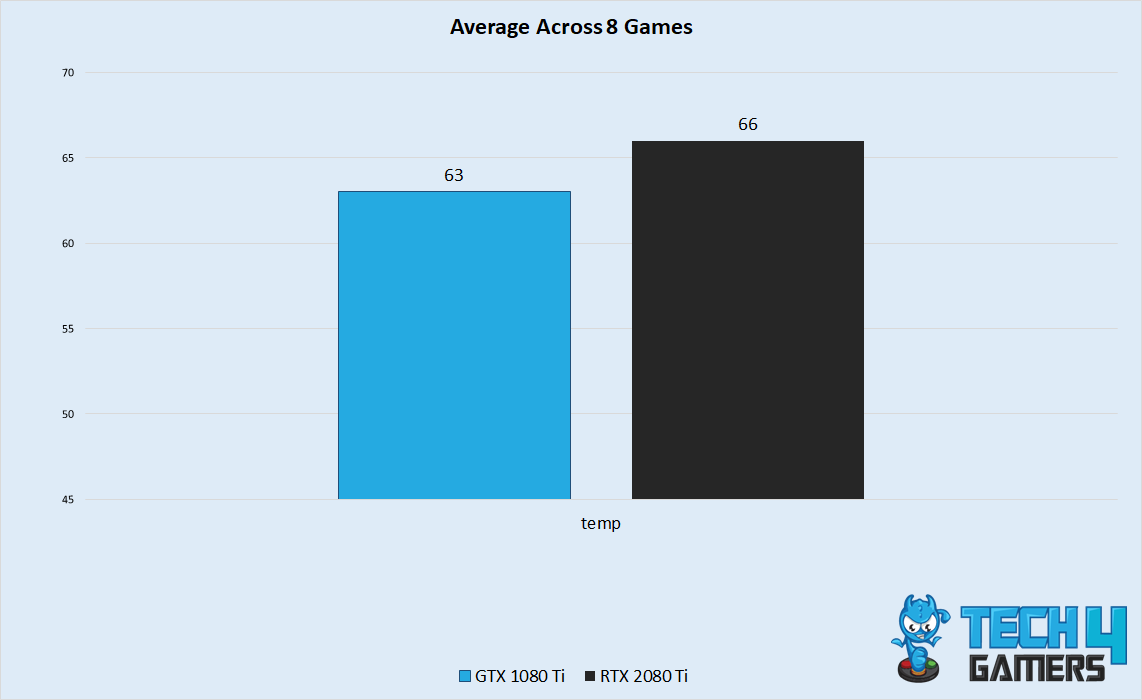
The temperatures in these tests were nothing to worry about for either of these cards. The GTX 1080 Ti had an average peak temperature of 63°C, whereas the RTX 2080 Ti had an average peak temperature of 66°C. The temperature difference between these cards does not suggest any benefit or drawback.
Winner: GTX 1080 Ti
Price And Availability
| GPU | MSRP | Current Price |
|---|---|---|
| GTX 1080 Ti | 💲699 | 💲570 |
| RTX 2080 Ti | 💲999 | 💲760 |
| Difference | 42.9% | 33% |
The RTX 2080 Ti has a performance per dollar of 0.18 frames/dollar, whereas the GTX 1080 Ti has a much better performance of 0.26 frames/dollar. The difference here comes out to about 42% favoring the 1080 Ti.
Final Verdict – Which One Should You Go For?
RTX 2080 Ti: Though It has a hefty price tag on average, you will likely find a great deal because of the age of this card. You will get buttery 1080p performance and enjoyable 1440p Ultra performance for this. This, along with its other bells and whistles like DLSS and Ray-Tracing support, makes it the more desirable card.
GTX 1080 Ti: On the other hand, the GTX 1080 Ti has merits and demerits. Though it is a noticeably slower GPU than the RTX 2080 Ti, with almost no modern creature comforts, it is still a great performer for the price. Because of the performance per dollar, this card would be an easy recommendation to anyone on a tighter budget looking to play high-end games.
In summary, if you want to spend more on the best performance and features, go for the RTX 2080 Ti. However, if you’re looking for a more budget-friendly option without sacrificing too much performance, the GTX 1080 Ti is still a solid choice.
FAQs
The GTX 1080 Ti does not support hardware-accelerated ray tracing. Some games try to brute force their way with ray tracing using the CUDA cores on the 1080 Ti, which gives less than desired results.
It might not be able to play at 4k with all the settings turned up, but the RTX 2080 Ti is generally capable enough to play games at 4k 60 FPS.
No, DLSS 3 and the accompanying frame generation are locked to the RTX 40 series of cards.
More From RTX 2080 Ti
More From GTX 1080 Ti
Thank you! Please share your positive feedback. 🔋
How could we improve this post? Please Help us. 😔
[Comparisons Expert]
Abdemanaf is a skilled creative writer who has been honing his craft since 2011. While initially working in different fields, he found a passion for technology and has been exploring the tech world since early 2015. Over the years, he has developed an in-depth knowledge of the latest tech trends and product offerings by various companies.
Abdemanaf’s writing reflects his analytical mindset and ability to think critically. He has a knack for breaking down complex technical information into easily digestible pieces, making his articles engaging and accessible to readers from all backgrounds. In February 2022, he joined Tech4Gamers as a blog and product comparison writer, where he has been able to hone his skills further.
As a writer, Abdemanaf is dedicated to staying up-to-date with the latest technological advancements and trends, enabling him to provide readers with the most relevant and accurate information. He is always eager to learn more and is constantly seeking new challenges to improve his skills.
Get In Touch: manaf@tech4gamers.com


